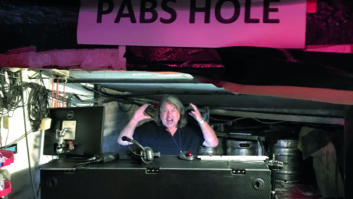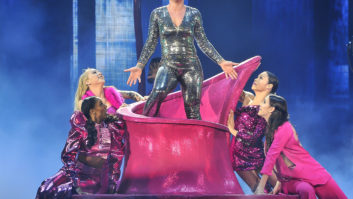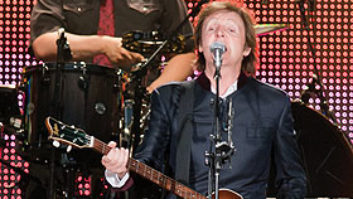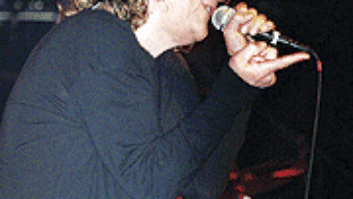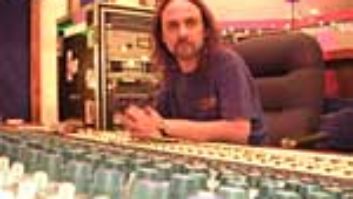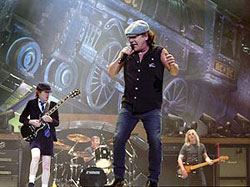
AC/DC is, from left, Angus Young, Phil Rudd, Brian Johnson and Cliff William. Not pictured: Malcolm Young.
Photos: Paule Saviano
“AC/DC is the best rock band there is,” enthuses front-of-house engineer Paul “Pab” Boothroyd. That means a lot coming from a man who’s been Paul McCartney’s live engineer for the past two decades, and whose list of clients includes Faith Hill and Paul Simon. Boothroyd has handled FOH duties for AC/DC since the band’s 1996 Ballbreaker Tour, and he’s back at the helm for their latest, the Black Ice World Tour, which promotes Black Ice, the group’s first album in eight years.
While there are a few moments of spectacle in the band’s new show — including a giant train that appears to smash onto the stage, and some fireballs for their anthem “TNT” — the set showcases the band doing what they do best: playing raunchy, blues-based rock. “[They’re] really like a pub band loud,” Boothroyd says. “That’s where they stem from, that’s where their roots are, and that’s how they like to be. Nothing fancy, no celebrity status, just go out and rock to the fans.”
An Analog World
Complementing their classic sound, Boothroyd mixes on a Clair Global-provided Midas Pro40 vintage analog console that was originally built for Dire Straits in the mid-’80s. “It’s a straightforward arena tour,” Boothroyd explains. “I’ve got my normal real-estate allocation of 12×12 or 16×12, so I can have a good analog desk with some racks of gear and look at [my mix as] old school because they are an old-school band.”
However, it’s not all analog at FOH. While mixing on the Pro40, Boothroyd simultaneously runs the band’s inputs through a Midas Pro-6 digital console to a multitrack recorder for archival purposes; the Midas can also serve as a backup board. “Taking out a vintage console like the Pro4, it did give me a few little worries that something could go wrong,” Boothroyd says. “The Midas Pro6 has got a great sound; comparing it to the Pro4, they are obviously different, but noticeably the 96k resolution and the treble frequencies are very sweet indeed.”
For outboard gear, Boothroyd uses Drawmer DS201 noise gates on the drums and a pair of dbx 160 Blues compressors on bass and guitars, and for vocal peaks: “They’re just a fantastic, studio-quality transparent compressor that I’ve used on all sorts of things.” He also uses Massenburg EML 8200 EQs. “I just wanted to have a couple of settable, notchable EQs when Brian [Johnson, lead singer] walks out right into the middle of the audience [on a runway]. So you have to just be able to notch out a few of those ring-y frequencies.”
Monitor engineer Mike Adams has Johnson and drummer Phil Rudd on Ultimate UE-11 in-ears, which were decided on “because they have the horsepower it takes,” Adams says. “The decision was made that [they] would probably be the only product that would get over that kind of volume.“
In addition, the band has Clair Firehouse F-15 wedges, with EVX and XB’s doing side-fills and zone-fills. “With ears and everything, I’ve got a total of 36 zones,” Adams says. “Everything is zoned out across the stage so that it can be tailored for any position of anybody moving about the stage with no problem.” Adams also mixes on an analog Midas desk, a Heritage 4000, to complement the group’s old-school sound. His outboard gear comprises TC Electronic 1128 EQs and DDLs, Avalon 737 preamp/compressors, Eventide H3000s, Yamaha PCM 91 reverbs and Empirical Labs Distressors.
Miking Challenges
One of Boothroyd’s hurdles is getting Johnson’s vocals above the incredible volume of the band. “Brian isn’t a very strong singer,” Boothroyd says. “Even a very strong vocalist would struggle with sitting on top of the level of the backline, which is measured at 120 dBs at [bassist] Cliff [William’s] backing vocal position. But Brian does have a unique voice and you can sit it in the mix; you just have to be careful about how you place things.
“I’ve got a Summit TLA-100 tube on the vocal, which just helps me to punch his vocal forward more in the mix. The makeup gain on it is great: You give it a little tweak and you can hear it come forward in the mix, and the compression quality on it is very, very smooth.”

Monitor engineer Mike Adams (left) and FOH engineer Paul Boothroyd—mixers about to rock
Johnson sings into a Shure SM58A, a microphone Boothroyd uses with many artists. “It’s robust, and it does everything I need it to do. It’s also good for the monitor engineer,” he explains. The backing vocals get 57As,“because we felt that the proximity effect of that particular mic was better [than the 58As].”
The drums are miked with Audix microphones: a D-6 on the kick (along with a Shure SM91), D-4s for the toms and two I-5s on snare top and bottom. “I just started to use [Audix mics] mainly on McCartney shows, and I felt like I immediately got a really great result without having to fiddle too much,” Boothroyd comments. There are also seven Audix Micro-Ds on the cymbals, which Boothroyd says help him to contain the sound. “It’s so loud up there that you could never put a pair of overheads up to get some kind of cymbal splash going on,” he explains. “And it’s a wide spread of cymbals so I mike each one individually, just to get that crash sound sitting in the mix. This show isn’t about fidelity or subtleness; it’s just about getting things placed in the mix very loud, very contained, hopefully controlled and that’s it. Turn it up and duck.”
As for guitar amps, it’s “Marshall, Marshall, Marshall, Marshall, 11, 11, 11, 11, loud, loud, lots of them,” Boothroyd says with a laugh. “There are about 20 [amp] cabinets up there. They are all flat-out — there’s no gimmick here, They’re there to spread guitar across the stage.” The cabinets have 100-watt Marshall heads, which have been tweaked by the tour’s amp technician to run hotter than a standard amp. “This is okay — it just means you go through a lot of tubes, but it gives it that sound,” Boothroyd says. “I put one mic on one cabinet, an Audio-Technica 4047. I’ve tried various microphones, much to Malcolm [Young, rhythm guitarist] and Angus’ [Young, lead guitarist] disgust because they’d be quite happy with just an SM57 on there. But I wanted to capture some other qualities, so I went for a slightly larger-diaphragm mic, and I found that the only one I really liked was the A-T 4047.”
A Clair EV X-Line line array system bolsters the heavy rock sound, with a hang eight wide by six deep, 10 i4s per side and 16 subs per side. “There’s plenty of these ‘pencil’ P.A.s out there that sound great, no problem there,” Boothroyd says. “But this show is very theatrical, as well. The big P.A. is a great look for the band because the show is about sound — a lot of bright lights, a lot of loud sound, a lot of hot pyro. And so they were happy to start off where we left off from Stiff Upper Lip. [The band used that same P.A. setup for that tour.] The backline is exactly the same setup, down to the drum kit; even the rear sidefills are exactly identical from how we left off eight years ago. The only thing we’re doing different now is using the Clair i4 side hangs to cover rear and sides of the venue. It’s that with some subs underneath the stage — very straightforward.”
“The only challenge is to make sure that things stay in some sort of control,” Adams adds. “Sonically, the band is amazing — it’s not like that’s a problem — it’s just that the sheer volume can create a lot of saturation. And I think that Pab and I work well with the synergy of it all.”
Gaby Alter is a New York City-based writer.
